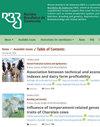Effects of negative pressure and directed ducted cooling systems on the performance of lactating sows
IF 1.2
4区 农林科学
Q3 Agricultural and Biological Sciences
Revista Brasileira De Zootecnia-Brazilian Journal of Animal Science
Pub Date : 2022-01-01
DOI:10.37496/rbz5120200275
引用次数: 0
Abstract
The objective of the present study was to evaluate the effects of cooling systems by negative pressure versus directed ducts on the performance of lactating sows and their litter. The experiment was conducted in a tropical climatic region in Brazil. Ninety-four lactating sows during 26.2±1.7 days of lactation were included with their 1,236 piglets. Sows were distributed using a completely randomized block design into two treatments: a negative pressure cooling (NPC) system and a directed duct cooling (DDC) system. We adopted sow parity as blocking criterion. During the experimental period, environmental temperatures inside the farrowing rooms were 22.9±1.5 and 25.4±2.5 °C, respectively, using the NPC and DDC systems. Sow daily feed intake, litter weight at weaning, piglet weight at weaning, litter daily weight gain, piglet daily gain, and daily milk production per sow were greater in the NPC system than in the DDC system. The type of cooling system did not affect piglet weight after standardization, mortality, number of piglets weaned per sow, and estrus return. The use of an NPC system can reduce the effects of higher environmental temperatures better than the DDC system. The NPC system allowed for greater feed intake, piglet and litter weight gain, weight of piglets and litter at weaning, and milk production compared with the DDC system.负压和定向管道冷却系统对泌乳母猪生产性能的影响
本研究的目的是评估负压冷却系统与定向冷却系统对泌乳母猪及其产仔性能的影响。实验是在巴西的热带气候区进行的。试验选取泌乳期26.2±1.7 d的94头泌乳母猪和1236头仔猪。采用完全随机分组设计,将母猪分为两组:负压冷却(NPC)系统和定向管道冷却(DDC)系统。我们采用母猪奇偶校验作为分块准则。实验期间,使用NPC和DDC系统,产房内环境温度分别为22.9±1.5℃和25.4±2.5℃。NPC系统的母猪日采食量、断奶窝重、断奶仔猪重、窝重日增重、仔猪日增重和每头母猪日产奶量均大于DDC系统。冷却系统的类型对标准化后仔猪重、死亡率、每头母猪断奶仔猪数和发情恢复没有影响。使用NPC系统可以比DDC系统更好地减少较高环境温度的影响。与DDC系统相比,NPC系统允许更大的采食量、仔猪和窝料增重、断奶仔猪和窝料重以及产奶量。
本文章由计算机程序翻译,如有差异,请以英文原文为准。
求助全文
约1分钟内获得全文
求助全文
来源期刊
CiteScore
1.90
自引率
0.00%
发文量
25
审稿时长
8 weeks
期刊介绍:
The Revista Brasileira de Zootecnia (RBZ; Brazilian Journal of Animal Science) encompasses all fields of Animal Science Research. The RBZ publishes original scientific articles in the areas of Aquaculture, Biometeorology and Animal Welfare, Forage Crops and Grasslands, Animal and Forage Plants Breeding and Genetics, Animal Reproduction, Ruminant and Non-Ruminant Nutrition, and Animal Production Systems and Agribusiness.

 求助内容:
求助内容: 应助结果提醒方式:
应助结果提醒方式:


